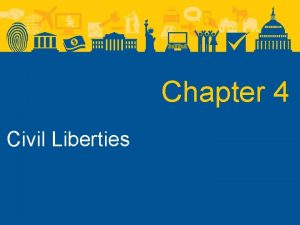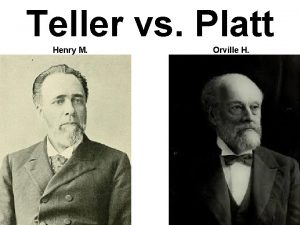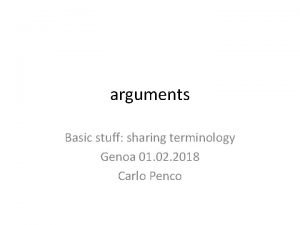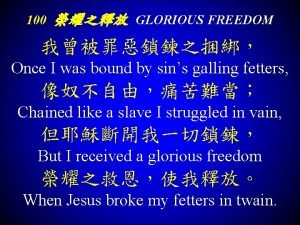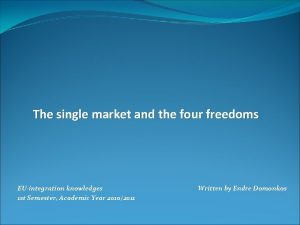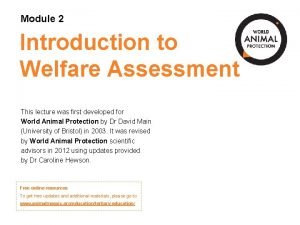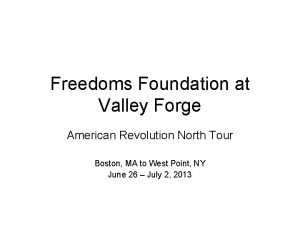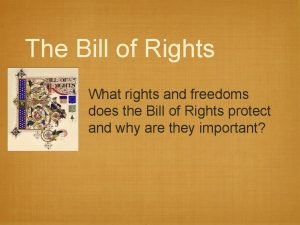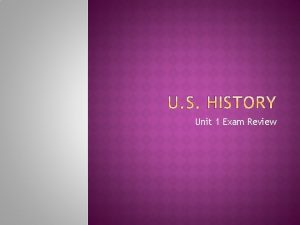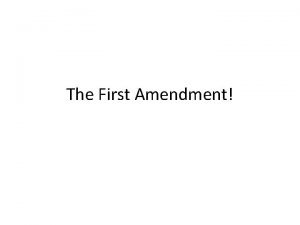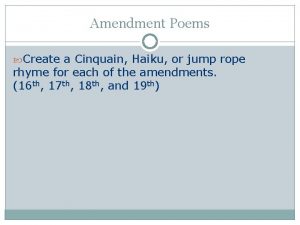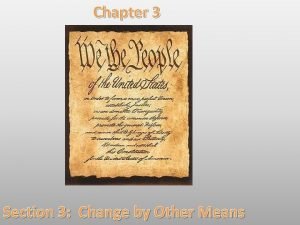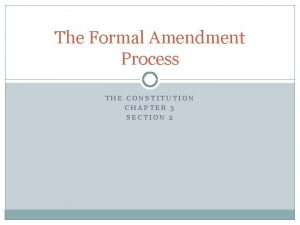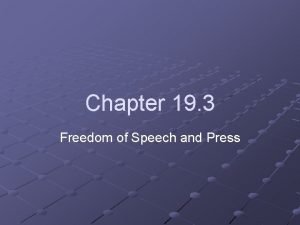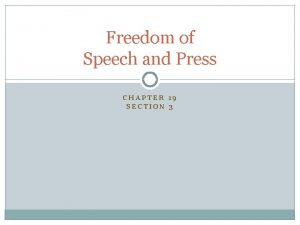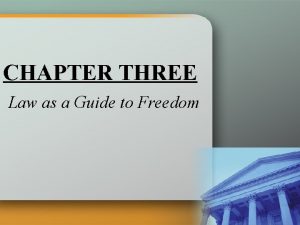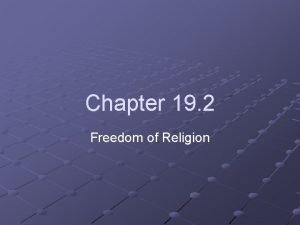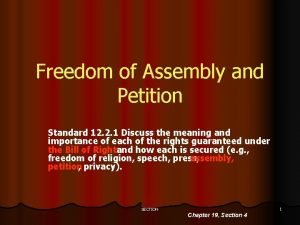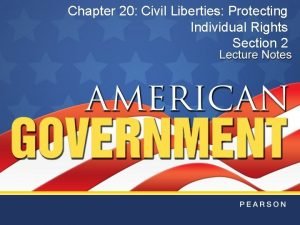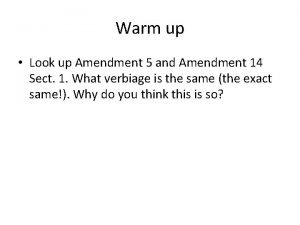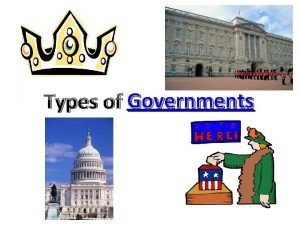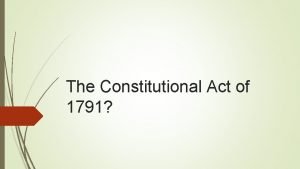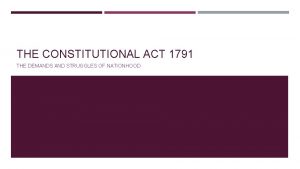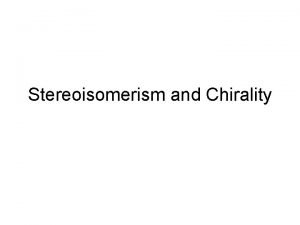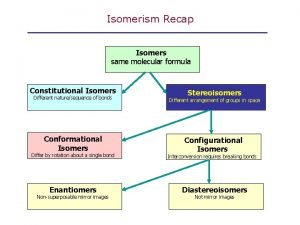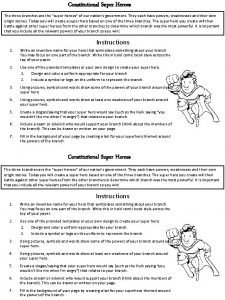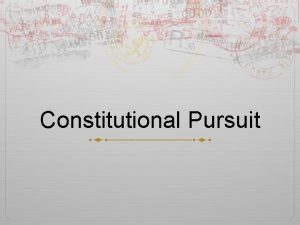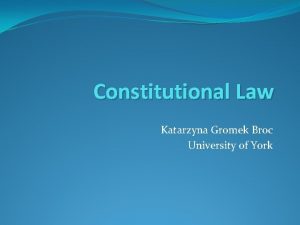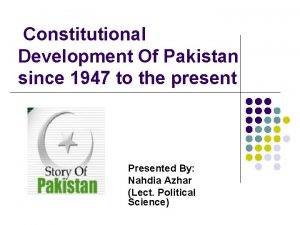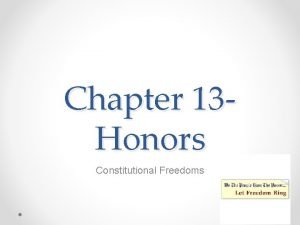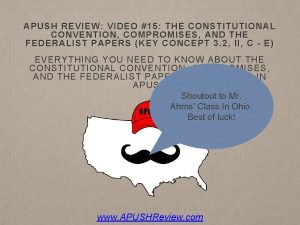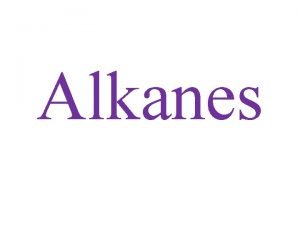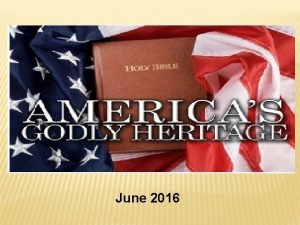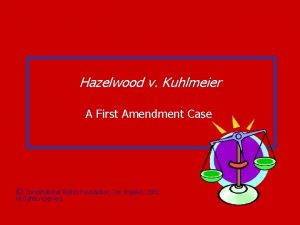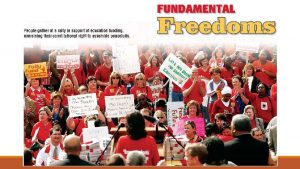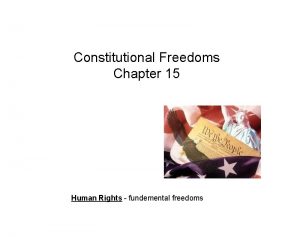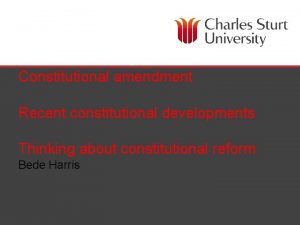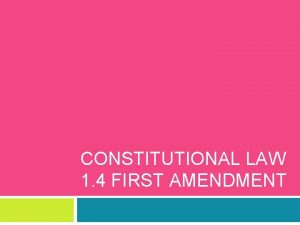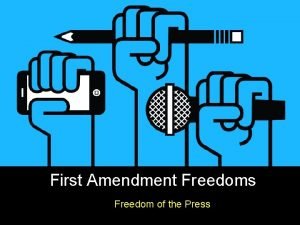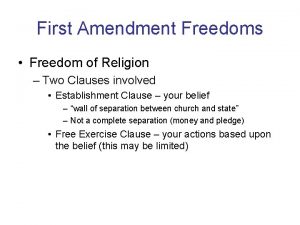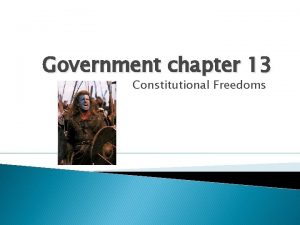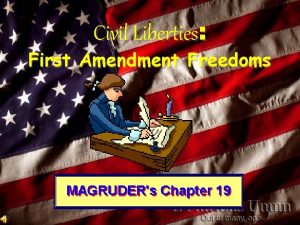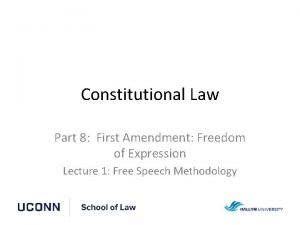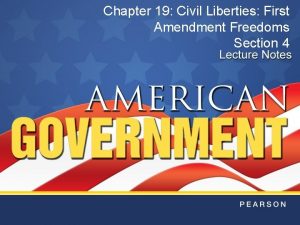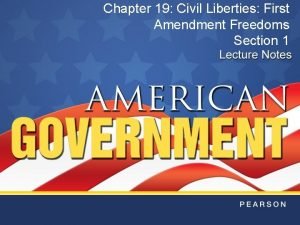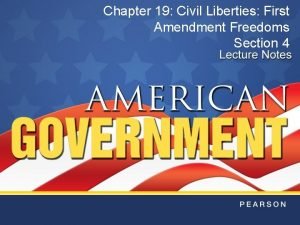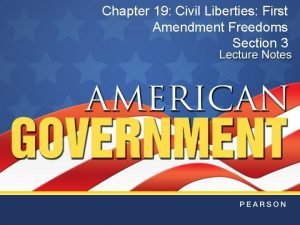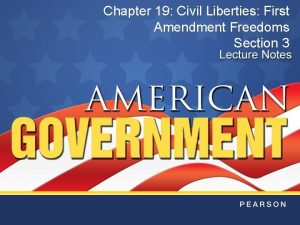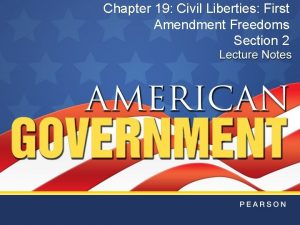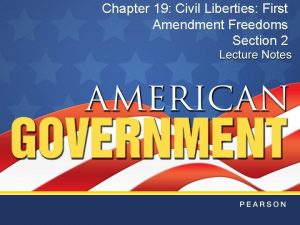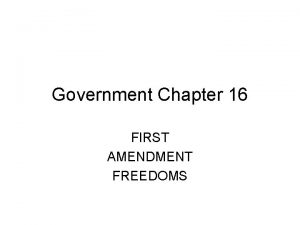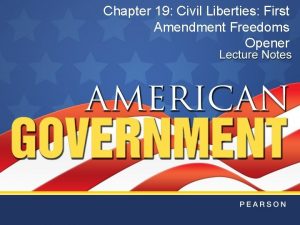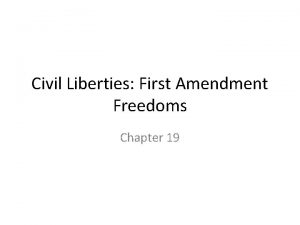Constitutional Freedoms The First Amendment Chapter 13 Freedom







































- Slides: 39

Constitutional Freedoms The First Amendment Chapter 13

Freedom of Religion Chapter 13, Section 2

Freedom of Religion n “Congress shall make no law respecting an establishment of religion or prohibiting the free exercise thereof” n First Amendment contains 2 clauses in regards to religion: 1. Establishment Clause 2. Free Exercise Clause

Establishment Clause n Establishment Clause: prohibits the establishment of an official, statesponsored religion or Church – Government should not favor one religion over another – Jefferson: “a wall between Church and State” n Separation of Church and State is very controversial, especially in the area of Education.

Written Analysis n Citation: n Topic: n Issue: n Facts: n Findings: n Reasoning:

Establishment Clause and Education n Everson v. Board of Education (1947): landmark case dealing with state funding to parochial schools (schools that are affiliated with a religion or Church) – court ruled that state-sponsored busing to parochial schools is constitutional because it benefits the students…. school didn’t touch the money – First Supreme Court case dealing with Establishment Clause

Establishment Clause and Education Supreme Court uses “Lemon” test in order to determine whether funds to a parochial school violates the First Amendment n Lemon v. Kurtzman (1971): Supreme court case dealing with state aid to parochial schools n – after this case, the court uses a three-part test to determine constitutionality of aid. Must meet the following requirements: 1. must have a secular (non-religious) purpose 2. aid neither enhances nor inhibits religion 3. avoids “excessive” governmental entanglement with

Establishment Clause and Education n Prayer in schools is also very controversial n Engel v. Vitale (1962): schools in New York had created a school-wide prayer and 10 parents challenged it. – Court ruled that the school prayer was a violation of 1 st Amendment – Since this case, the court has ruled on various cases to uphold the 1 st Amendment

Establishment Clause and Education n Student Religious groups are also examined within the context of the First Amendment. n Equal Access Act of 1984: allows student initiated religious meetings before and/or after school hours.

Establishment Clause and Education Teaching evolution in schools is yet another controversial topic. n Supreme Court has ruled that it is unconstitutional to ban the teaching of evolution in schools. (Epperson v. Arkansas) n It is also unconstitutional to require the teaching of creationism because to do so is to endorse a religious doctrine. (Edwards v. Aguillard) n – most schools will introduce both topics as THEORIES, but do not attempt to force the issue of creationism.

Other Issues with the Establishment Clause n The Establishment Clause is addressed in other areas beyond education. – Religious displays § Lynch v. Donnelly (1984): Supreme Court ruled that it is ok to use a Nativity scene in public displays as long as it is accompanied by secular decorations (Santa, reindeer, Christmas tree, etc. ) – Prayer before Government meetings § Marsh v. Chambers (1983): prayer before govt. meetings does not violate Establishment Clause because legislators are not susceptible to religious peer-pressure and it has been tradition since the foundation of the state of Nebraska and it indicated the intent of the founding fathers

Free Exercise Clause n Free Exercise Clause: allows people to worship and practice religion without governmental interference n Court has made distinction between the right to believe and the right to practice – right to believe is absolute – right to practice is restricted

Free Exercise Clause Religious practice may be limited when the religious practices conflict with laws. n Reynolds v. United States: George Reynolds was a Mormon and his religion permitted the practice of polygamy (having multiple spouses), which is prohibited by federal law. n – He was convicted for bigamy and he appealed – Supreme Court upheld his conviction n People are not free to carry out religious practices that violate the law – Throughout the years, court has upheld this principle

Free Exercise Clause n -Minersville School District v. Gobitis (1940): Jehovah’s Witnesses challenged the practice of saluting the American Flag because their religion prohibits them to bow down to any graven image – Court ruled that the flag is a patriotic symbol and thereby does not violate freedom of religion

Free Exercise Clause n -After the Gobitis case, West Virginia passed a law requiring students to salute the flag or face punishment. – Once again, the Jehovah’s Witness community challenged the law. n West Virginia State Board of Education v. Barnette (1943): Court overturns the Gobitis ruling – Rules that such laws are an infringement of the 1 st Amendment n (These cases illustrate how the Supreme Court can change its interpretation of the Constitution)

Freedom of Speech Chapter 13, Section 3

Freedom of Speech n Types of Speech: Speech comes in a variety of forms – Pure Speech: verbal expression, most common form of speech – Symbolic Speech: involves actions, symbols to express opinion Pure speech is easier to protect. Symbolic speech is less easy to protect because it involves actions. n Court has ruled that actions that endanger public safety are not protected under the 1 st Amendment. n

Symbolic Speech n Court has ruled that wearing black armbands to protest Vietnam War is Constitutional (Tinker v. Des Moines) and flag burning is a protected form of symbolic speech (Texas v. Johnson). – (US v. Eichman) – “If there is any principle of the Constitution that more imperatively calls for attachment than any other, it is the principle of free thought—not free thought for those who agree with us but freedom for the thought that we hate. “ Justice Oliver Wendell Holmes, Jr. n On the other hand, the court has upheld various laws that limit symbolic speech.

Restricting Symbolic Speech n Speech is often regulated in an attempt to protect society. – Example: Congress has outlawed seditious speech: speech that urges resistance to the law or advocating the overthrow of the govt. n Throughout history, the court has developed three guidelines when dealing with free speech: – – – “Clear and Present Danger” rule Bad tendency doctrine Preferred position doctrine

Clear and Present Danger n First Amendment does NOT protect speech that presents an immediate danger – When there is a conflict between free expression and public safety, the need to protect the public will often win out n Clear and Present Danger test was developed as a result of the Schenck v. United States – Schenck was prosecuted for obstructing the war effort during WWI, Court upheld the ruling and considered public safety and national security to be more important than 1 persons right to free speech.

Bad Tendency Doctrine n During 1920’s the court developed a new philosophy on speech – Speech could be restricted if it has a tendency to lead to illegal activity § Would lead to even stricter regulations on speech – This doctrine is less popular today, but there are still supporters § Some believe that the need to maintain order is more important than basic freedoms

Preferred Position Doctrine n Developed during the 1940’s, the Preferred Position doctrine holds that the First Amendment is most important amendment – It guarantees basic freedoms that are essential to liberty – As such, laws that limit the 1 st Amendment are unconstitutional unless the govt can prove them to be necessary

Defining and Limiting Seditious Speech n Speech is sometimes limited in times of national security – Espionage Act 1917 – Sedition Acts (1940’s-50’s) § One law made it illegal to advocate revolution – Communist Party leaders were arrested and convicted in 1951 – 1957: Court overturned convictions of Communist leaders § Made distinction between telling people a revolution is needed and actually encouraging them to launch one – Patriot Act 2001 n First Amendment does not protect speech that is intended to incite acts of violence

Other forms of Unprotected Speech Beyond seditious speech, other forms of speech are not protected by the Constitution n Defamatory Speech: false speech that damages a persons reputation n – Making false, hurtful comments about a person when you known them to be untrue is unconstitutional – 2 Categories for defamatory speech § Slander: spoken § Libel: written – Persons can be sued for saying things that damage another persons reputation

Other Forms of Unprotected Speech n “Fighting Words”: words that are so insulting that they incite immediate violence – Are not protected forms of speech

Other Forms of Unprotected Speech n Student Speech is also limited n Supreme Court has determined that it is the right of school officials to decide what constitutes acceptable speech while at school n Student speech can be regulated by school officials – KRS 158. 150 use of profanity or vulgarity


Freedom of the Press Chapter 13, Section 4

Freedom of the Press n What is the press? – Founding Fathers envisioned protection of print media § Newspapers, magazines, pamphlets – Technology has created new sources of press § Broadcasts: TV and Radio § Internet and Email § Social Media § Movies § Advertising

Freedom of Press is protected because it is closely tied to the freedom of Speech n Supreme Court has ruled on censorship of the press n Supreme Court has outlawed prior restraint n – Prior Restraint: censorship before publication § Outlawed except in cases of national security – Two landmark cases dealing with prior restraint

Prior Restraint n Near v. Minnesota (1931) – Minnesota passed law prohibiting publication of “malicious, scandalous, or defamatory” speech – Editor of a paper was heard calling local officials “gangsters” and “grafters” – His newspaper was censored for fear that he might print such comments – Supreme Court rules in his favor; ruled that this was a case of prior restraint and, therefore, not allowed

Prior Restraint Supreme Court later rules again in a prior restraint case n NY Times Co. v. U. S. (1971) n – A. K. A. Pentagon Papers case – Former Pentagon employee leaked classified documents detailing U. S. involvement in Vietnam War – – – § Proved that the govt. had been lying to the public Gave papers to NY Times for publication Govt. tried to censor the publication Supreme Court ruled in favor of the newspaper § Considered it important for the people to be informed about the papers and truth about Vietnam War

n Daniel Ellsberg New York Times Court Ruling President Nixon responds with Watergate Scandal Impeachment Resignation – President Nixon wrote book No More Vietnams (1985) -"No event in American history is more misunderstood than the Vietnam War. It was misreported then, and it is misremembered now. Rarely have so many people been so wrong about so much. Never have the consequences of their misunderstanding been so tragic. "

Other Issues dealing with Free Press Print forms of press enjoy more protection under 1 st Amendment n Broadcast media is less protected n – Radio, Cable and TV broadcasts are regulated by the FCC (Federal Communication Commission) n Internet is considered to be another form of press and media – Supreme Court considers content on internet to be another form of speech and eligible for protection under the First Amendment n Court has seen cases dealing with obscenity in the press n Advertising has long been restricted and regulated – Considers it to be the communities responsibility to decide what is obscene – These restrictions began to lessen during the 1970’s

Freedom of Assembly Chapter 13, Section 5

Assembly n Closely related to speech n Assembly allows people to gather in groups with the purpose of expressing an opinion n Right to demonstrate and assemble is protected by the First Amendment

Freedom of Assembly n Some restrictions on freedom of assembly: – Must get permit to launch a public demonstration – Police can break up any violent demonstrations – Demonstrations must not interfere with the rights of others § Ie. Demonstrations outside a courthouse that interfere with a trial – Can’t demonstrate on private property

Labor Picketing n Labor Unions have the right to picket during a strike – Demonstrate outside of a company in hopes of bringing the employer to the bargaining table – Strikes and picketing are a controversial topic § Changing views throughout history

Right to freedom of association n First Amendment also protects our rights to join organizations – Political parties – Special interest groups
 Chapter 19 civil liberties first amendment freedoms
Chapter 19 civil liberties first amendment freedoms Civil liberties first amendment freedoms
Civil liberties first amendment freedoms Teller vs platt amendment
Teller vs platt amendment Positive freedom negative freedom
Positive freedom negative freedom Glorious freedom wonderful freedom
Glorious freedom wonderful freedom Four freedoms of the eu
Four freedoms of the eu Four freedoms of the eu
Four freedoms of the eu Module 2 the animal world
Module 2 the animal world Freedoms foundation teacher programs
Freedoms foundation teacher programs Freedoms
Freedoms Freedoms
Freedoms Which statement best summarizes chapter 11
Which statement best summarizes chapter 11 1st amendment simplified
1st amendment simplified 4th amendment poem
4th amendment poem Change by other means
Change by other means Nc first in freedom
Nc first in freedom Formal amendment process 4 methods
Formal amendment process 4 methods Chapter 19 section 3 freedom of speech and press
Chapter 19 section 3 freedom of speech and press Chapter 19 section 3 freedom of speech and press
Chapter 19 section 3 freedom of speech and press Chapter 3 law as a guide to freedom
Chapter 3 law as a guide to freedom Chapter 19 section 2 freedom of religion
Chapter 19 section 2 freedom of religion Chapter 19 section 4 freedom of assembly and petition
Chapter 19 section 4 freedom of assembly and petition Chapter 20 section 2 freedom and security of the person
Chapter 20 section 2 freedom and security of the person Gitlow v new york constitutional question
Gitlow v new york constitutional question Who governs a dictatorship
Who governs a dictatorship Constitutional act of 1791
Constitutional act of 1791 Constitutional act 1791
Constitutional act 1791 Constitutional isomer
Constitutional isomer Right to constitutional remedies
Right to constitutional remedies Isomers of c7 h16
Isomers of c7 h16 Constitutional isomers
Constitutional isomers Legislative branch superhero slogan
Legislative branch superhero slogan Constitutional pursuit answer sheet
Constitutional pursuit answer sheet Scope of constitutional law
Scope of constitutional law Constitutional development in pakistan from 1947 to 1973
Constitutional development in pakistan from 1947 to 1973 Gitlow v new york constitutional question
Gitlow v new york constitutional question Constitutional compromises
Constitutional compromises 5 isomers of hexane
5 isomers of hexane Constitutional convention 1787
Constitutional convention 1787 Hazelwood v kuhlmeier arguments for both sides
Hazelwood v kuhlmeier arguments for both sides
